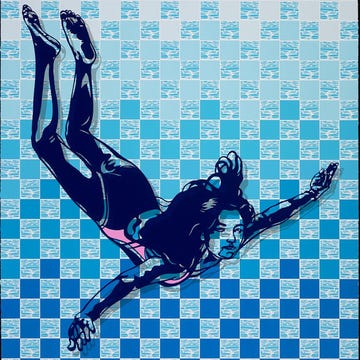Harry Lawson “Peter” Carr (1925–1981) was a comparative literature professor at Cal State Long Beach and an outsider artist who celebrated—and struggled with—his hometown of Orange County. Carr was not formally trained as an artist. He earned his PhD from USC, and he served in the navy. I first encountered Carr through his Aliso Creek, a howling anthem of an illustrated prose poem anthologized by Lisa Alvarez and Andrew Tonkovich in Orange County: A Literary Field Guild. Having lived in Newport Beach during my formative teen and early-adult years, I saw much of my own ambivalence with the region—a love-hate elixir I grapple with in my own work—reflected in Carr’s writings and paintings.
This Q&A was adapted from the Alta Weekly Newsletter, delivered every Thursday. To keep reading, become an Alta Journal member for as little as $3 a month.
SIGN UP
Now Carr is the subject of a retrospective show at the art gallery at Cerritos College in Norwalk running through December 13. Peter Carr: Artist for Survival, curated by Tonkovich, brings together Carr’s paintings, portraits, posters, manuscripts, and self-published writings, which form an artistic, poetic, and political record of SoCal life in the 1970s. Tonkovich, editor of the Santa Monica Review, considered Carr a mentor and maintained a storage space packed full of the rarely seen works showing at Cerritos.
I conducted this email interview with Tonkovich to learn more about why he is so determined to secure Carr’s place in Southern California’s cultural history.
This interview has been edited for length and clarity.
You were Carr’s student at Cal State Long Beach. In 1981, Carr died of a heart attack. How did you inherit his work? How long did you know him? Why did he have such a commanding impact?
Peter was even more than a young person actively looking for a charismatic, radical mentor could have asked for. I found him, and he made me the person I am, but I probably actually knew him for all of 18 months. I doubt that, at age 20, I even understood his influence. A decade later, when Lisa [Alvarez] and I moved to Orange County for grad school, I got close to his partner, Jeanie, in South Laguna. I asked, and she allowed me to start sorting, cataloging, and writing about the work, which was buried in the garage, stacked behind the washer-dryer, stuffed in bankers boxes.
Your vision of Orange County—from the freeways to the malls, the megachurches, the architecture, the light—is despairing yet persistently hopeful. Can you explain this?
Orange County is the last place Lisa and I expected to end up. But to crib from Peter, who played with the idea of the “discovery”—or, more pointedly, rediscovery—of this place, we sought out revisionist and alternative history and political comrades. We found it. Ironically or hopefully, we celebrated the literary history of this county in our anthology, Orange County: A Literary Field Guide. In fact, the storage unit where I keep what I call the Peter Carr Storage of Self, Bespoke Art Gallery and Impossible Reliquary sits right under the horrible toll road. It’s got the Santa Ana Mountains on one side and the right-wing evangelical megachurch and suburban sprawl on the other, with a view of what’s left of chaparral and sycamores and sage. It’s not hard to see the irony. He would have hated it. He would have loved it. He would have painted it. In fact, he did!
Do you have a favorite Carr art piece?
Part of my self-appointed job—I was a teacher, after all—is to place him in a tradition, or at least try to. His self-published book Aliso Creek is a cri de coeur, an autobiography, a warning. It’s a retelling of the history of Orange County and Southern California by way of what he calls a “holy” place. Sure, it makes fun of the everyday alienation of tourists or commuters from the natural world, but it’s also a kind of invitation or reminder. To them and to the viewer. So, a combination of sarcasm and sincere invitation. Here’s the challenge, suggests Peter. Now what are we gonna do about it?•
The author of three novels and two story collections, Victoria Patterson lives with her family in South Pasadena and teaches fiction in Antioch University’s master of fine arts program.












